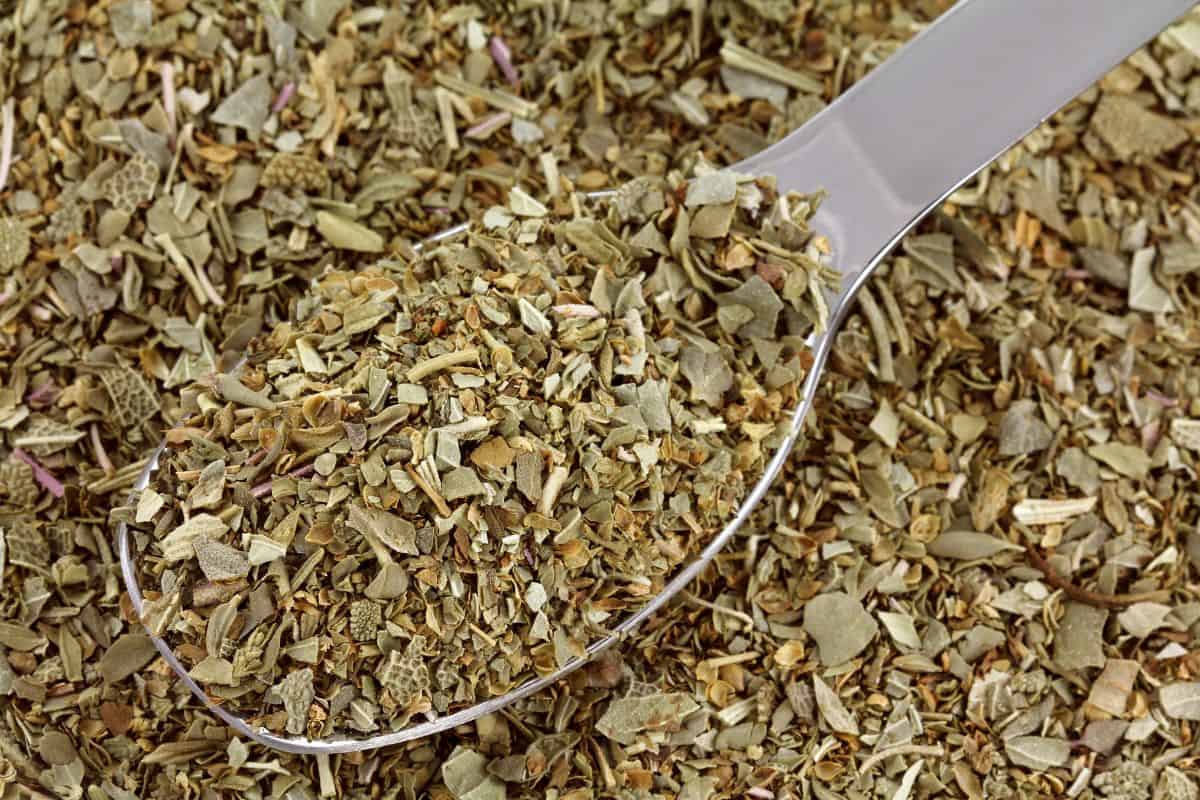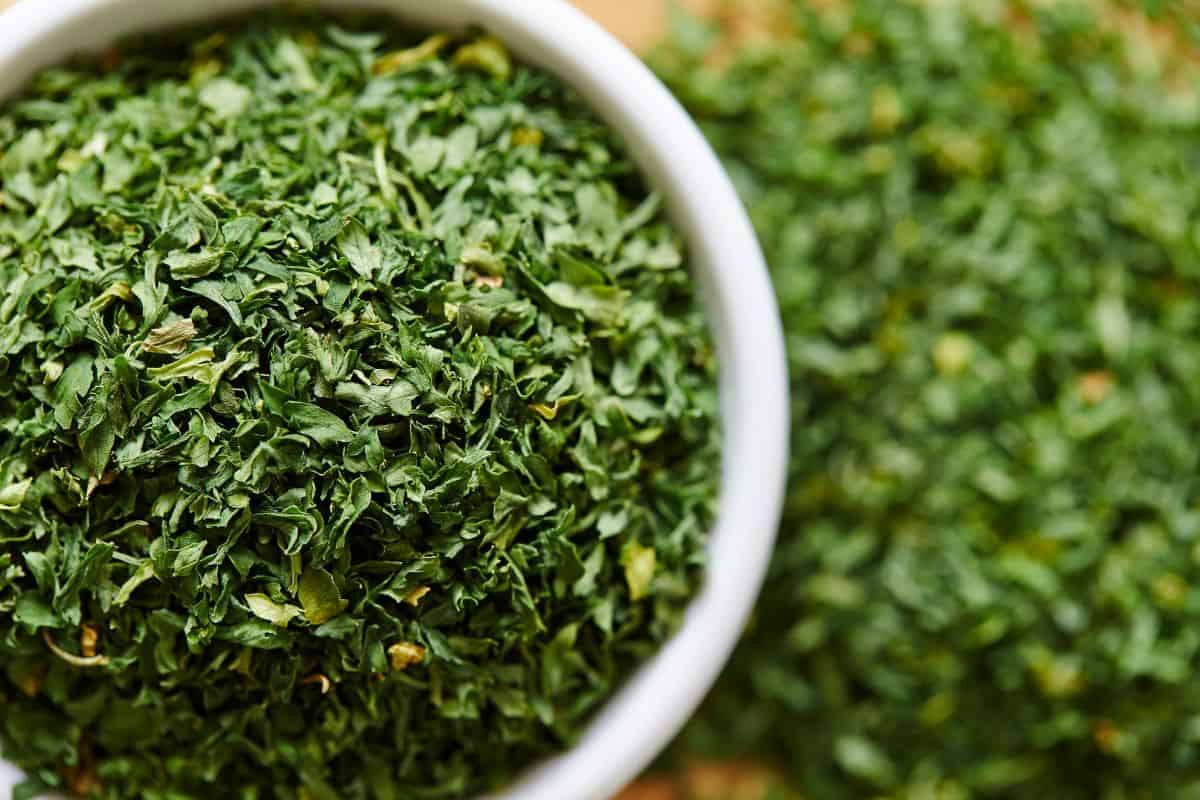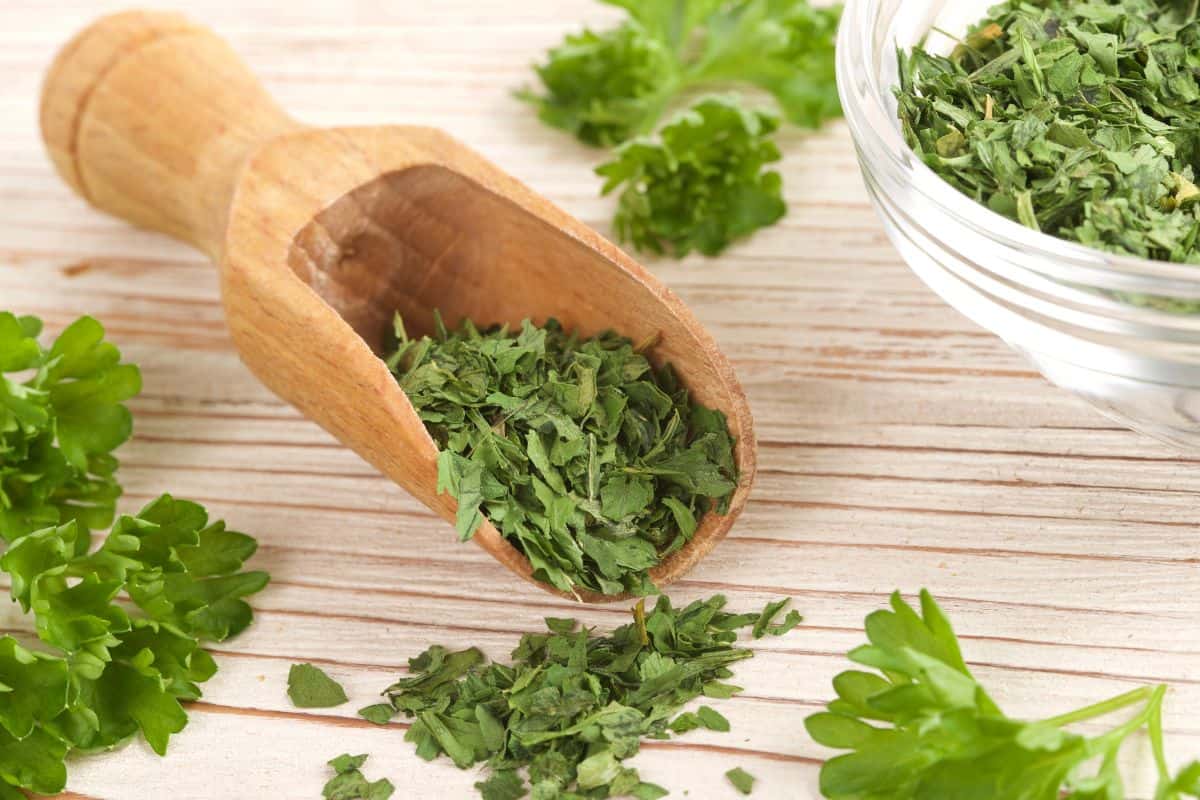What is Italian Seasoning?
Italian seasoning is a blend of dried herbs with earthy and piney flavors and hints of sweetness and pepper. However, there are several substitutes for Italian Seasoning. Its origin is hazy; some claim it first came from America, while others assert it came from Italy.
It is general knowledge that the Greeks and Romans created Italian seasoning in the ancient Mediterranean. It contains dried herbs, usually basil, oregano, marjoram, thyme, rosemary, sage, and savory.

What Can I Substitute for Italian Seasoning?
Homemade Italian Seasoning
One of the best things about Italian seasoning is that you can make it at home with minimal effort. Besides, you can get a good substitute for Italian seasoning. If you have all of the necessary Italian herb substitutes, all you need to do is measure and combine them. The ingredients and proportions for your homemade Italian seasoning are as follows:
- 2 tablespoons basil
- 1 teaspoon marjoram
- 2 tablespoons oregano
- 1 teaspoon garlic powder
- 1 tablespoon rosemary
- 2 tablespoons parsley
- 1 tablespoon thyme
- 1 tablespoon red chili flakes
If you already possess all of these ingredients, follow the complete recipe for Italian seasoning for detailed instructions on how to combine and store your homemade Italian seasoning. Even if you only have a few of these components, you might still be able to come up with an excellent alternative.
Please continue reading to find out how to improve the flavor of your dish by using each of these herbs in their capacities. There is no need for concern if you do not possess any of these spices in your kitchen.
You may have another fantastic replacement for Italian seasoning stashed away in your cabinet. Investigate the other spice mixtures that can stand in for Italian seasoning and see which ones you prefer.
Herb Substitutes
Basil + Oregano
Even though this recipe calls for two different herbs, when combined, they make a simple and speedy Italian seasoning substitute. Since basil and oregano are the two primary ingredients in Italian seasoning, using them as a flavor substitute offers the most similar experience possible. They are also two of the most typical spices in a standard kitchen.
You can make this simplified version of Italian seasoning even if you don’t have all the spices needed to make your Italian seasoning. To replace one tablespoon of Italian seasoning, mix equal parts of basil and oregano in a ratio of 2:1; for example, use two teaspoons of basil and one teaspoon of oregano.
Basil
You can also use Basil on its own if desired. Even though it won’t bring the same level of depth as mixing it with oregano, it will give the dish an Italian flavor. Basil has an earthy and sweet flavor when consumed on its own.
An overwhelming flavor might result from using too much of any one spice. Because of this, you should only use one-half of the amount of Italian seasoning that the recipe calls for.
Oregano
Oregano’s signature earthy scent and flavor are often the first things that come to people’s minds when they think of Italian food. This aromatic herb may stand on its own as a formidable competitor.
Therefore, it should use only a small amount by itself. Reduce the amount of oregano by one-half. You can always add more if required, or you may blend it with any of the other herbs you already have on hand.

Thyme
Thyme is yet another wonderful herb that exemplifies the classic flavors associated with Italian cooking. Oregano is also a type of mint, and so is this type of mint. Even though thyme is less potent than oregano, you should still start with only one-half of the amount called for in the recipe.
Sage
Dry sage possesses a unique and quite potent flavor. Its flavor complements the flavors of other herbs, such as oregano and thyme. However, when used by itself, it has the potential to overwhelm the different flavors in a recipe quickly.
You will only need a small amount when using sage on its own. Try blending with one or two other spices after beginning with a quarter of the amount. This gives a wonderful dry Italian seasoning substitute.
Marjoram
Oregano and thyme are two members of the mint family that are a part of. It has a similar earthy flavor, but there are hints of mint in there as well. It is sweeter than the first two herbs and less intense than oregano. To get started, use only a quarter of marjoram.
Rosemary
Although you will frequently include rosemary in Italian seasoning, it does not stand out as the most prominent flavor. It plays a role in bringing together and enhancing the taste of the other primary components.
Because of this, employing rosemary on its own will result in a distinct alteration in the flavor. Try your recipe with just a quarter of rosemary at first. If you need more, continue to do so gradually.
Parsley
The flavor of parsley is more subdued when compared to that of other herbs. As a result, it is an excellent option to use on its own if you don’t want a lot of flavors added to the meal you’re preparing.

Spice Blend Substitutes
In addition to Italian seasoning, you can serve several other spice combinations with various kinds of food around the world. Even while every one of these mixtures has its distinctive flavor, many have a flavor profile that is fundamentally the same.
Herbes De Provence
Herbes de Provence is a traditional ingredient in regional French cuisine. It consists of the same spices utilized in the production of Italian seasoning. Lavender is a welcome addition to the oregano and fennel.
The incorporation of lavender, tarragon, and fennel alterations results in the production of an entirely new flavor profile. As a result, you need to pay attention to the foods you combine them with. Traditionally, it goes well with chicken, eggs, and vegetables that grow from the ground, such as root vegetables.
If you believe that the ingredients in your meal will benefit from adding Herbes de Provence, give it a shot! This beautiful spice blend will take the flavor to the next level. Start with a quantity that is half what you normally would to prevent the new flavor from dominating the flavor profile of the dish. You present Herbes de Provence in a silver dish in the wide overhead view.
Greek Seasoning
Greek seasoning is a further spice combination comparable to Italian seasoning in terms of its characteristics. Oregano, basil, parsley, and garlic powder form a robust base for this seasoning blend, reminiscent of traditional Italian flavors.
In addition to that, it typically consists of dill, onion powder, and ground black pepper. Adding new flavors, like Herbes de Provence, will cause a change in the flavor profile of the dish you are preparing. Dill is the unique predominant flavor in this particular instance. When employed, dill has a powerful presence, even when just a small amount is present.
Therefore, you must consider how the dill will work with the other components. Also, think about whether or not the people you are preparing the meal for like the flavor of dill. Even though it contains additional flavors, you can substitute Greek seasoning with Italian seasoning in a ratio of 1 to 1.
Pizza Seasoning
It may sound like pizza seasoning, and Italian seasoning is the same, but there are some key distinctions between them.
Although it begins with the same base as Italian seasoning, it differs from that blend in that it typically includes the addition of powdered garlic, onion, and fennel. Although not included in Italian seasoning, the following three additional spices are frequently used in traditional Italian cuisine.
Because of this, you can consist of Pizza Seasoning in most foods that call for Italian seasoning. In most cases, you can replace Italian Seasoning with Pizza Seasoning using a one-to-one ratio.
Za’atar
There is a good chance that you have some Za’atar stashed away in your spice cupboard if you do a lot of cooking Middle Eastern food. Oregano is the foundation of Za’atar, just as it is of many other seasonings worldwide. Additionally, it contains thyme.
The addition of sesame seeds gives za’atar its distinctive flavor. This simple and unique blend is extremely versatile. It is commonly used as a lamb flavoring, and some claim it is delicious when sprinkled on popcorn. In many different recipes, you can swap out Italian Seasoning for Za’Atar and get the same results.
Begin by adding only half of what you need in the recipe if you are unsure how the ingredient will affect the finished product’s taste (or needed).
Cajun
This particular spice mixture is the one that most resembles Italian seasoning less than any other! However, the Cajun seasoning’s incredibly robust flavors make it a superb compliment to various recipes.
If you want to change the overall flavor profile of your dish from the earthy tones that Italian seasoning imparts to a smoky flavor with a kick, try substituting Cajun Seasoning for Italian seasoning.
Because Cajun Seasoning introduces an entirely new flavor character, it is best to begin with a very low dose. You may finish up using a ratio of exactly 1:1, but it is advisable to add it gently until you find the new flavor that is just right.
Fresh Herbs
Although Italian seasoning is traditionally a mix of dried spices, if you have fresh herbs on hand, you can use those instead and achieve the same flavor. If you are going to use fresh herbs, choose herbs that are typically available in Italian seasonings, such as:
- Basil
- Oregano
- Parsley
- Thyme
- Rosemary
- Marjoram
Fresh herbs’ flavor is easier to extract than dried herbs’ flavor. Because of this, you will need to use a greater quantity to achieve the desired flavor. The precise proportions will vary from one person to the next based on the available fresh herbs.
What is Italian Seasoning Made of?
If you would rather produce your Italian seasoning, the process is not difficult at all, and doing so will offer you complete control over the components. When you make your spice and herb blends, you can choose which tastes to include and how much of each flavor to have.
If there is a particular dried herb you enjoy using, feel free to put an additional tablespoon or two of it in your mixture. If you do not enjoy the taste of any herbs, feel free to leave them out. Here’s what you need:
- 3 tablespoons dried basil
- 3 tablespoons dried oregano
- 3 tablespoons dried rosemary
- 3 tablespoons dried thyme
- 3 tablespoons dried marjoram
- Optional: Dried sage, dried savory, crushed red pepper flakes, or fennel seeds
Is Italian Seasoning the Same as Oregano?
Oregano and Italian seasoning are two separate and distinct spices. Oregano is just one of the numerous components that make Italian seasoning. If you don’t have any oregano on hand, you can substitute Italian seasoning for the role that oregano normally plays in the recipe.
Oregano, parsley, thyme, and marjoram are some herbs typically combined to make up Italian seasoning. Given that oregano is already contained in Italian seasoning, you could use Italian seasoning instead of oregano in a pinch. The Italian seasoning typically includes a variety of herbs and spices, including oregano.
Oregano, parsley, thyme, and marjoram are some herbs typically combined to make up Italian seasoning. This indicates that if you do not have any oregano on hand, you can commonly substitute Italian seasoning for the role that oregano would normally play.

How to Make Your Italian Seasoning at Home
You can always use this method when you need to replace Italian seasoning in a recipe. Because you may find that your homemade Italian seasoning recipe is superior to store-bought Italian seasoning, you don’t typically purchase Italian seasoning from the store.
You can control the quality of the ingredients as well as the flavors more effectively if you make your Italian seasoning. Many of the Italian seasonings you can purchase in stores contain fillers, preservatives, or anti-caking agents; others may not have ingredients of a high enough quality.
When you make your substitute for Italian seasoning, you have complete control over the components that go into it. Typical Italian seasoning has various dried herbs are grown in Italy or the region surrounding Italy.
That is actually where the name comes from, as Italian seasoning is a spice blend that comes from the United States to assist home cooks here in the United States in easily creating meals inspired by Italian cuisine. Most store-bought Italian seasonings include the following dried herbs and spices:
- Basil
- Parsley
- Oregano
- Thyme
- Rosemary
- Marjoram
- Sage
Garlic powder, black pepper, fennel seeds, and crushed red pepper flakes, which you may sometimes use as additional ingredients. After you have finished making your Italian seasoning at home, you may keep it for up to six months in a container with a tight lid. For such purposes, I like to save spice jars even after they are through with their uses.
What Do You Use Italian Seasoning for?
Italian seasoning is an aromatic all-purpose seasoning that you can use for a wide variety of dishes, including spaghetti sauce, pasta salad, and other words involving pasta, garlic butter, meatballs, fish, seafood, and chicken.
You can flavor many with Italian seasoning, but some of our favorites are traditional Italian-American dishes like meatballs, pizza, and chicken Parmesan. You can use Italian seasoning to flavor just about anything. Adding this ingredient makes olive oil for dipping bread or vinaigrette for salads more interesting.
However, here are the ways you can use your Italian seasoning:
- Rub for whole cuts of meat (chicken, pork, or beef)
- Marinade (like for herb-marinated pork chops)
- Meatballs (like these one-pan Italian turkey meatballs with marinara)
- Pizza (sprinkled on top or to make the sauce like in this deep dish pizza)
- Soups / Stews (like Italian meatballs and orzo soup)
- Pasta Sauce
- Topping bread like focaccia
- Italian Vinaigrette
- Sprinkled over salad
The Word’s Out!
Are you attempting to cook a dish that requires Italian seasoning, but you don’t have any in hand? A common herb blend found in Mediterranean cuisine is Italian seasoning. Even though it has an Italian name, it is not Italian.
Italian seasoning is a spice blend that comes as a convenience for cooks so that they can quickly add a flavor profile reminiscent of dishes from the Mediterranean. Oregano, basil, and thyme are typically in the spice mixes sold in grocery stores, but various combinations are available. Are you having trouble locating the Italian seasoning in the supermarket where you shop?
We’ve got you taken care of. You can rely on the information in this article. We have provided you with sufficient Italian seasoning alternatives you can still use. In addition, we have shown you how to make your Italian seasoning at home by using ingredients you can find in your immediate neighborhood. Get out there and establish a name for yourself with your excellent cooking.

Community of passionate writers and content creators who share a love for Italian heritage, culture, travel, food, and the Italian-American community. Our mission is to celebrate Italy’s rich history and traditions and connect with others who share the same passion.

